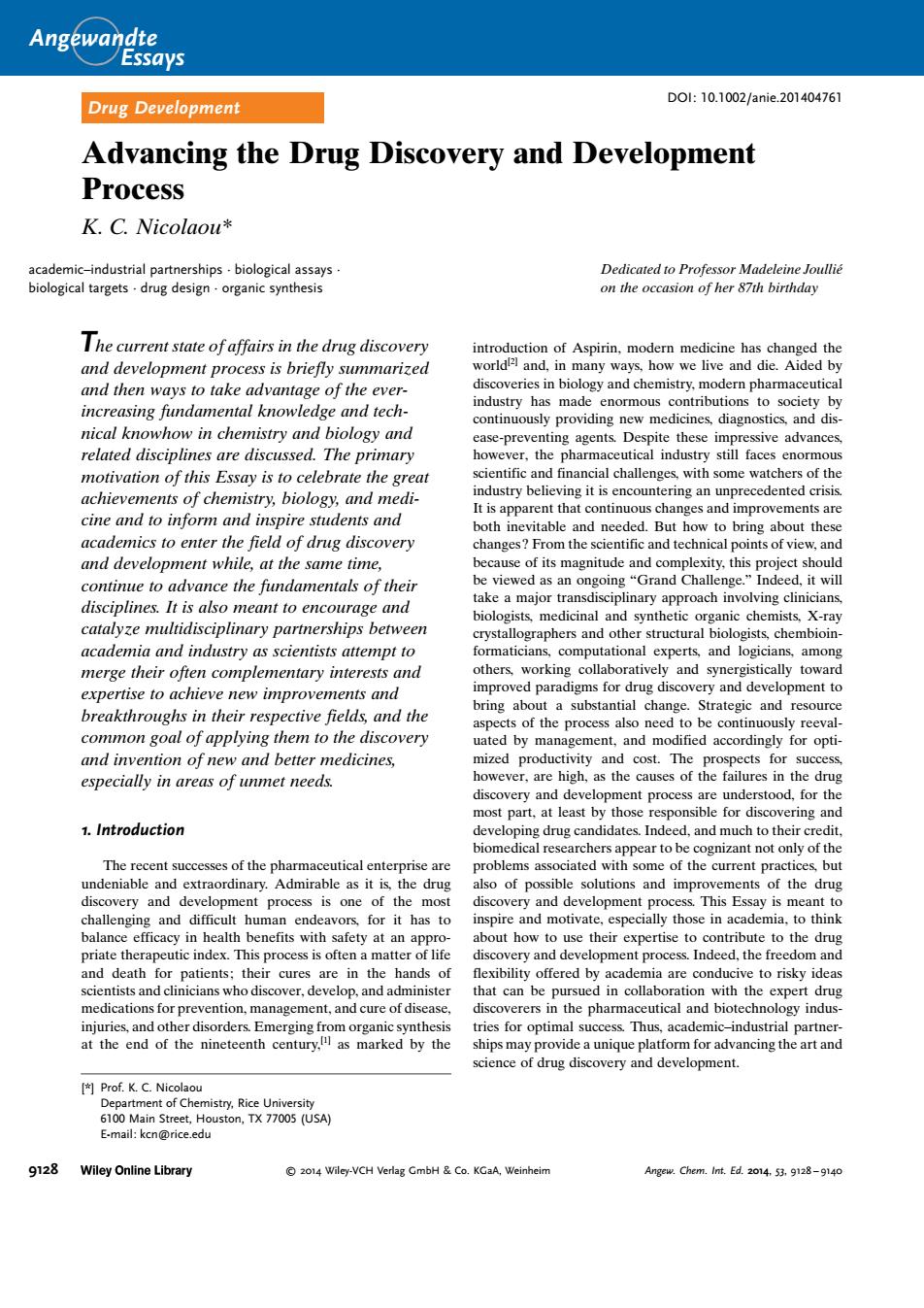正在加载图片...

Angewangrtays Drug Development D01:10.1002/anie,201404761 Advancing the Drug Discovery and Development Process K.C.Nicolaou" Dedicated to professor madeleine foullie on the occasion of her 87th birthday The current state of affairs in the drug discovery and development process is briefly summarized and then ways to take advantage of the ever increasing fundamental knowledge and tech mous c es.diagnos nical knowhow in chemistry and biology and related disciplines are discussed.The primary cal industry still face motivation of this Essay is to celebrate the great achievements of chemistry,biology,and medi cine and to inform and inspire students and ha nanges and academics to enter the field of drug discovery and development while,at the same time. continue to advance the fundamentals of their disciplines. ake a major transd isciplinary approach inv oing clini an meant to encourage and aphers and other structural biologists chen ndustry mputational exp and I merge covery and d nent to and th ts of the uss also nowever.are high,as the causes of dn espec 1.Introduction The recent suce es of the pha maccutical enterpris the hu has to eutic index.This pre ss is often a n natter of life Indeed the cur are in th vith th anagem t.and cure of dis discoverers in e pharm tical and bic gy indus at the end of the nineteenth century marked by the hins mav provide a uniaue eplatform for advancing the art and cience of drug discovery and development 的Prof.K.C..Nic 9128 Wiley Online LibraryDrug Development DOI: 10.1002/anie.201404761 Advancing the Drug Discovery and Development Process K. C. Nicolaou* Dedicated to Professor Madeleine Joulli on the occasion of her 87th birthday academic–industrial partnerships · biological assays · biological targets · drug design · organic synthesis 1. Introduction The recent successes of the pharmaceutical enterprise are undeniable and extraordinary. Admirable as it is, the drug discovery and development process is one of the most challenging and difficult human endeavors, for it has to balance efficacy in health benefits with safety at an appropriate therapeutic index. This process is often a matter of life and death for patients; their cures are in the hands of scientists and clinicians who discover, develop, and administer medications for prevention, management, and cure of disease, injuries, and other disorders. Emerging from organic synthesis at the end of the nineteenth century,[1] as marked by the introduction of Aspirin, modern medicine has changed the world[2] and, in many ways, how we live and die. Aided by discoveries in biology and chemistry, modern pharmaceutical industry has made enormous contributions to society by continuously providing new medicines, diagnostics, and disease-preventing agents. Despite these impressive advances, however, the pharmaceutical industry still faces enormous scientific and financial challenges, with some watchers of the industry believing it is encountering an unprecedented crisis. It is apparent that continuous changes and improvements are both inevitable and needed. But how to bring about these changes? From the scientific and technical points of view, and because of its magnitude and complexity, this project should be viewed as an ongoing “Grand Challenge.” Indeed, it will take a major transdisciplinary approach involving clinicians, biologists, medicinal and synthetic organic chemists, X-ray crystallographers and other structural biologists, chembioinformaticians, computational experts, and logicians, among others, working collaboratively and synergistically toward improved paradigms for drug discovery and development to bring about a substantial change. Strategic and resource aspects of the process also need to be continuously reevaluated by management, and modified accordingly for optimized productivity and cost. The prospects for success, however, are high, as the causes of the failures in the drug discovery and development process are understood, for the most part, at least by those responsible for discovering and developing drug candidates. Indeed, and much to their credit, biomedical researchers appear to be cognizant not only of the problems associated with some of the current practices, but also of possible solutions and improvements of the drug discovery and development process. This Essay is meant to inspire and motivate, especially those in academia, to think about how to use their expertise to contribute to the drug discovery and development process. Indeed, the freedom and flexibility offered by academia are conducive to risky ideas that can be pursued in collaboration with the expert drug discoverers in the pharmaceutical and biotechnology industries for optimal success. Thus, academic–industrial partnerships may provide a unique platform for advancing the art and science of drug discovery and development. [*] Prof. K. C. Nicolaou Department of Chemistry, Rice University 6100 Main Street, Houston, TX 77005 (USA) E-mail: kcn@rice.edu The current state of affairs in the drug discovery and development process is briefly summarized and then ways to take advantage of the everincreasing fundamental knowledge and technical knowhow in chemistry and biology and related disciplines are discussed. The primary motivation of this Essay is to celebrate the great achievements of chemistry, biology, and medicine and to inform and inspire students and academics to enter the field of drug discovery and development while, at the same time, continue to advance the fundamentals of their disciplines. It is also meant to encourage and catalyze multidisciplinary partnerships between academia and industry as scientists attempt to merge their often complementary interests and expertise to achieve new improvements and breakthroughs in their respective fields, and the common goal of applying them to the discovery and invention of new and better medicines, especially in areas of unmet needs. Angewandte . Essays 9128 2014 Wiley-VCH Verlag GmbH & Co. KGaA, Weinheim Angew. Chem. Int. Ed. 2014, 53, 9128 – 9140��